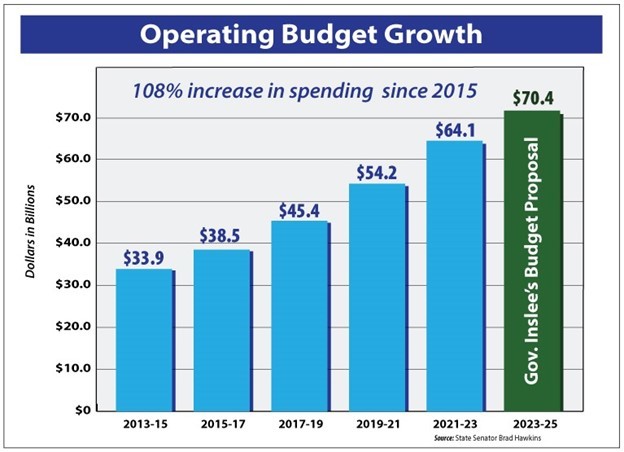|
March 21, 2023
Dear Friends and Neighbors,
The major focus of the current legislative session is to develop and approve budgets for the 2023-2025 biennium. Washington state budgets on a two-year basis and develops three budgets: the operating, transportation, and capital budgets. The three budgets will go into effect July 1, 2023, for the 2023-2025 biennium. Budget authorization will end June 30, 2025. After the House and Senate approve their respective budget proposals, the two chambers then appoint budget negotiators to discuss the differences between the budgets. All three budgets are very significant, but the operating budget is the largest and receives significant attention.
The operating budget funds the day-to-day operations of the state, including K-12 education, higher education, human services, natural resources, and other programs. Forty-three percent of the state expenditures are dedicated to K-12 education and are protected by the State Supreme Court’s McCleary decision.
Operating budget overview
The operating budget funds the day-to-day operations of the state, including early learning, K-12 education, higher education, health and human services, criminal justice, natural resources, and other areas. The Washington state operating budget has grown considerably over the past 15 years and is $64.1 billion for 2021-2023. The budget writers also develop the operating budget based on a four-year outlook, even though the budget cycle is technically two years. The state’s reserve account is projected to be $6.6 billion at the end of the biennium. A portion of the total reserves is the Budget Stabilization Account, often referred to as the “Rainy Day Fund.” The current balance is $650 million. Each biennium or two-year period, legislators consider the estimated revenues and review expenditures to determine any adjustments to be made. Similar to other bills, the budgets need to be approved both the House and Senate and signed by the Governor in order to go into effect.
 |
The state operating budget has grown significantly over recent years, far outpacing population growth and inflation. Some – but not all – of these spending increases were in response to the 2012 State Supreme Court’s McCleary decision on K-12 education funding. Governor Inslee has proposed a $70.4 billion budget for 2023-25. This level of spending concerns me considering the uncertainty in the national economy.
Reviewing expenditures and revenues
In terms of state expenditures, much of the spending (43%) is dedicated to K-12 education with funding allocated to 295 school districts based on student enrollment and established formulas. Other spending includes such things as early learning, higher education, human services, corrections, debt service, long-term care, health care, and natural resources. On the revenue side, most of the taxes collected include the state portion of the sales, B&O, and state school tax. The state collects the remaining revenue from other charges and fees. The Washington State Economic and Revenue Forecast Council is responsible for estimating the incoming revenues and provides quarterly reports to the state. The next revenue forecast will be released this month and will help guide operating budget development during the final weeks and months of session. For more information about state budget, click fiscal.wa.gov or A Guide to the Washington State Budget Process.

The budgets are complicated proposals that require months of development. Each budget is a separate bill that advances through their respective committees and eventually to the Senate floor for a full debate and vote. I will work hard to convey our district’s interest in each budget.
2023-2025 operating budget proposals
The state normally follows a traditional process for budget development. This process includes the governor releasing his budget proposal prior to the legislative session and the House and Senate developing their own proposals during session. The House and Senate are expected to release their budget proposals in April. Given the size and scope of the operating budget as well as differing philosophies about revenues and spending, it is common for differences to exist among the three budget proposals. Ultimately, all three sides (House, Senate, and Governor) need to agree on the exact same budget document in order for it to be enacted into law. When deep differences exist, sometimes the budget negotiations carry on toward the end of the fiscal year before a final agreed-upon budget is enacted. The current fiscal year ends June 30, 2023, and the new budget begins July 1, 2023. The budget authorizes expenditures for two years: July 1, 2023 – June 30, 2025.

The overall revenues for the 2023-25 operating budget are expected to be $66.2 billion. Most of the budget revenue is a result of sales taxes and business taxes but other taxes provide smaller sources of revenue.
Thank you for the opportunity to serve
My position as State Senator exists to serve you. If you have any questions about the session timeline, state budgets, or other topics, please contact me at senatorbradhawkins.org. Please call our Legislative Hotline at 1-800-562-6000 if you need immediate assistance at any time. Be sure to like and follow me on Facebook @SenatorBradHawkins, for my latest updates.
Thank you for the opportunity to serve as your state senator.
Sincerely,

Brad Hawkins
State Senator Brad Hawkins
12th Legislative District
Website: senatorbradhawkins.org
Facebook: @SenatorBradHawkins
107 Newhouse Building - P.O. Box 40412 | Olympia, WA 98504-0412
(360) 786-7622 or Toll-free: (800) 562-6000
|